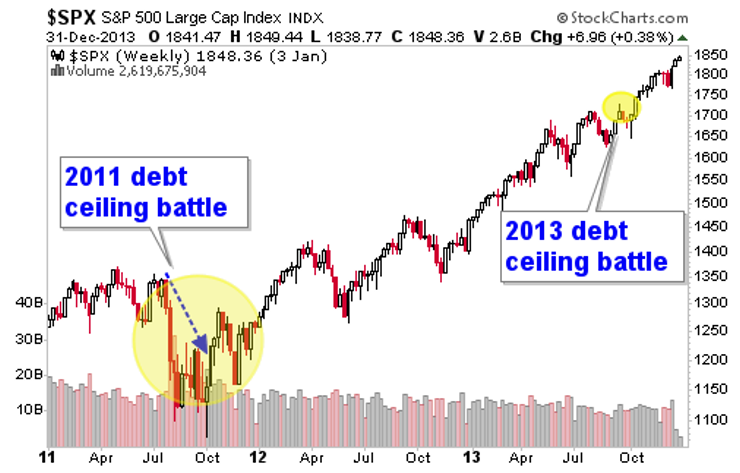The clock is ticking on America’s debt ceiling crisis. The debt ceiling is the federally mandated limit on how much money the U.S. can borrow to pay its bills.
And we’re already in this crisis. It began at the end of July when a Congressional suspension of the federal debt limit ended. We’ll run smack into a wall on Sept. 30 — that’s when emergency funding measures will be exhausted, and the U.S. could go into default.
What happens between now and then could shake the market to its roots. How do we know? Because we’ve seen this story play out before in 2011.
During that standoff over the debt ceiling, the S&P 500 sank by more than 18%!
What’s more, the U.S. went into technical default for four days. Federal and state governments were roiled by temporary layoffs that echoed through the economy.
This time around, the political battle lines are drawn sharper and harder.
In fact, 46 Republican Senators have signed a letter flatly saying they will not budge on the debt ceiling unless spending cuts are made. And Senate Minority Leader Mitch McConnell says Democrats shouldn’t expect any Republican help on the debt limit. In a political body where you need 60 votes to get anything done, it sure seems like we’re headed for a crisis.
The Republicans point out that America is running a deficit of $1.2 trillion this year, and that’s before President Biden’s $1.9 billion COVID-19 relief bill and $1.2 trillion infrastructure bill are accounted for, both of which are multi-year packages.
On the other hand, President Trump and the Republicans added $7.8 trillion to the national debt when they were in charge. Part of that was pandemic relief, but a bigger part was the $1.8 trillion in tax cuts made in 2018 — tax cuts focused narrowly on the very wealthy.
Democrats tried to roll back those tax cuts to pay the bills, but Republicans flatly refused to do so. Again, you need 60 votes to get anything done.
We Need to Do Something to Balance the Budget
The Congressional Budget Office (CBO) projects cumulative budget deficits will total $12 trillion over the next decade. And the fact that we are pushing the limit on the $28.5 trillion Uncle Sam is legally allowed to borrow is mind-boggling. But in the short term, we need to get it done.
If the government can’t borrow to pay its bills, that triggers a whole bunch of consequences:
• Suspension of pensions.
• Cutting or stopping military and federal worker pay.
• Delaying payment of interest on the debt.
That last part is where we go into default.
In the 2011 debt ceiling battle, Standard & Poor’s stripped the U.S. of its AAA credit rating for the first time. Then-Treasury Secretary Timothy Geithner warned a real default would drive borrowing costs sharply higher for state and local governments, companies and individuals.
In fact, the cost of insuring Treasury debt surged from 25 basis points before the 2011 crisis to about 75 basis points after.
Geithner also warned a continued default would result in widespread job losses and a recession deeper than we saw in the 2008 financial crisis.
Fast forward to June 2021: Treasury Secretary Janet Yellen told Congress another debt ceiling failure could trigger another financial crisis. She also said Uncle Sam could run out of emergency funds sooner than last time.
Then, in July, ratings firm Fitch said its outlook on the U.S. debt was negative, specifically citing the looming fight over the debt ceiling in its outlook.
It Doesn’t Have to Be a Catastrophe
There was also a debt ceiling battle in 2013 — it was resolved more quickly than 2011, and the market barely noticed the dust-up in the halls of Congress.
Sure, there are other forces that push the market around. But let’s look at today’s market:
• The S&P 500 hasn’t undergone a single correction of even 5% over the past nine months! Normally, we’d expect at least one 10% correction during that time frame.
• The S&P 500’s Shiller P/E ratio, a measure of valuation, was recently 38.64. That’s more than double its 151-year average of 16.84.
• Here’s a bigger worry: the previous four times the S&P 500’s Shiller P/E topped and sustained 30, the index subsequently declined by at least 20%.
In the short term, the market is looking for a correction. And the debt ceiling battle may be the shove down the stairs.
An even bigger risk is that, during a protracted default, the U.S. dollar’s status as the world reserve currency could be tarnished. America receives many benefits from having the U.S. dollar be the world’s reserve currency. A change in that status would be absolutely devastating.
Billionaires to the Rescue?
Republicans seem intransigent on raising the debt ceiling. But considering how a default may impact the economy and corporate profits, Wall Street could come to the rescue. Wall Street titans and hedge fund managers could call Senate Republicans and tell them to make a deal if they want to keep receiving campaign contributions.
So, if you’re cynical about this whole process, you’re also optimistic that it’s all showboating, and Republicans will come around eventually.
On the other hand, if you think Republicans mean what they say, then there is a crisis dead ahead, and it’s hard to say what it will take to swerve America from its disastrous course.
Invest for a Roller Coaster Market
I’m expecting wild swings. I’ve recommended my paying subscribers add hedge positions that will pay off if the market tanks — but I’m keeping plenty of long positions in stocks that have bright futures. After all, in the wake of the 2011 debt ceiling fight, the S&P 500 quickly rallied back, then went on to march 13% higher the next year!
One thing you could do is pick up some physical gold. I’ve explained it’s very cheap right now. But in a bitter, mud-flinging, credit-shattering debt ceiling fight, the dollar could be in real trouble.
And that’s when real wealth like gold will shine.
All the best,
Sean




